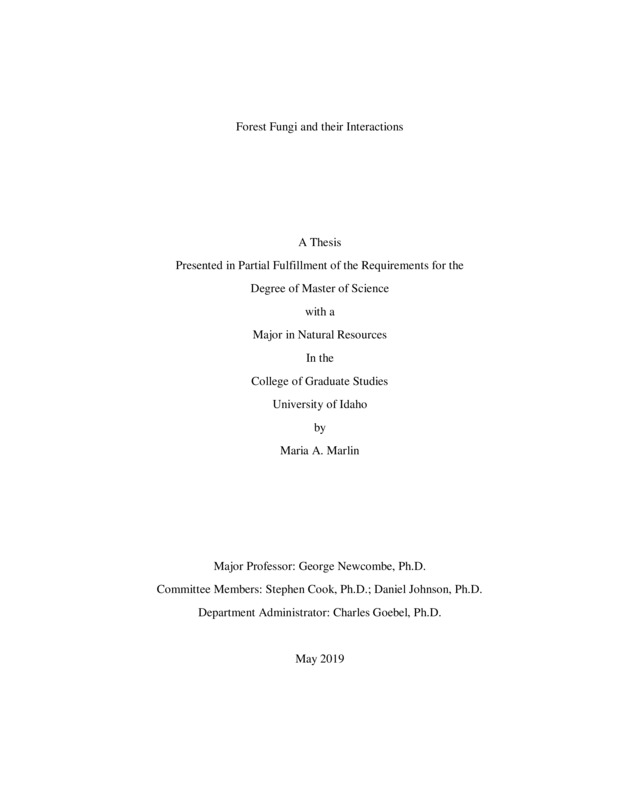Forest Fungi and their Interactions
Marlin, Maria. (2019-05). Forest Fungi and their Interactions. Theses and Dissertations Collection, University of Idaho Library Digital Collections. https://www.lib.uidaho.edu/digital/etd/items/marlin_idaho_0089n_11533.html
- Title:
- Forest Fungi and their Interactions
- Author:
- Marlin, Maria
- Date:
- 2019-05
- Program:
- Natural Resources
- Subject Category:
- Plant pathology
- Abstract:
-
Fungi are ubiquitous in a forestry setting; they can function as endophytes in plant tissues, as plant pathogens, and as wood decomposers. Plant endophytes can play a tremendous role in plant ecology, fitness, and evolution. Plant pathogens are microbes with a sinister ability to threaten food security and destroy precious and prized forests. Plant resistance to these harmful microbes provides the plant some protection from pathogens and their harmful effects. However, resistance can be overcome, so new solutions are always needed. Fungi that decompose wood are crucial in nutrient cycling. This thesis explores different guilds of forest fungi and how their interactions provide insight into overall forest ecology and health.
The first chapter contains results from a study conducted to determine where the most antagonistic endophyte interactors are found within different plant tissues. An important forest tree, Pinus monticola or Western White Pine was used as a model system. The seed contains specialized endophytes that were more dynamic interactors than their vegetative counterparts. This information is applicable to the current quest of locating effective antagonistic microbes to use against damaging plant pathogens.
Secondly, we report that copy number variation in hybrid poplar affects response to infection by Melampsora rust. Rust inoculations on mutated P. deltoides × P. nigra lines demonstrated that there are dosage-dependent genes for both rust resistance and rust susceptibility. Additionally, a novel Melampsora hybrid rust is discussed and characterized. Combined, these chapters offer insights into microbial interactions with both each other and their hosts, and how we can harness this information to reduce disease susceptibility.
The third chapter details a study that investigates host ranges of both nematophagous fungi and fungivorous nematodes. Nematophagous Pleurotus pulmonarius consumes some nematodes; other nematodes, however, are resistant to the P. pulmonarius toxin. Resistant nematodes begin to consume Pleurotus pulmonarius, even though they are currently only viewed as ‘bacterial feeders’.
- Description:
- masters, M.S., Natural Resources -- University of Idaho - College of Graduate Studies, 2019-05
- Major Professor:
- Newcombe, George
- Committee:
- Cook, Stephen; Johnson, Daniel
- Defense Date:
- 2019-05
- Identifier:
- Marlin_idaho_0089N_11533
- Type:
- Text
- Format Original:
- Format:
- application/pdf
- Rights:
- In Copyright - Educational Use Permitted. For more information, please contact University of Idaho Library Special Collections and Archives Department at libspec@uidaho.edu.
- Standardized Rights:
- http://rightsstatements.org/vocab/InC-EDU/1.0/

